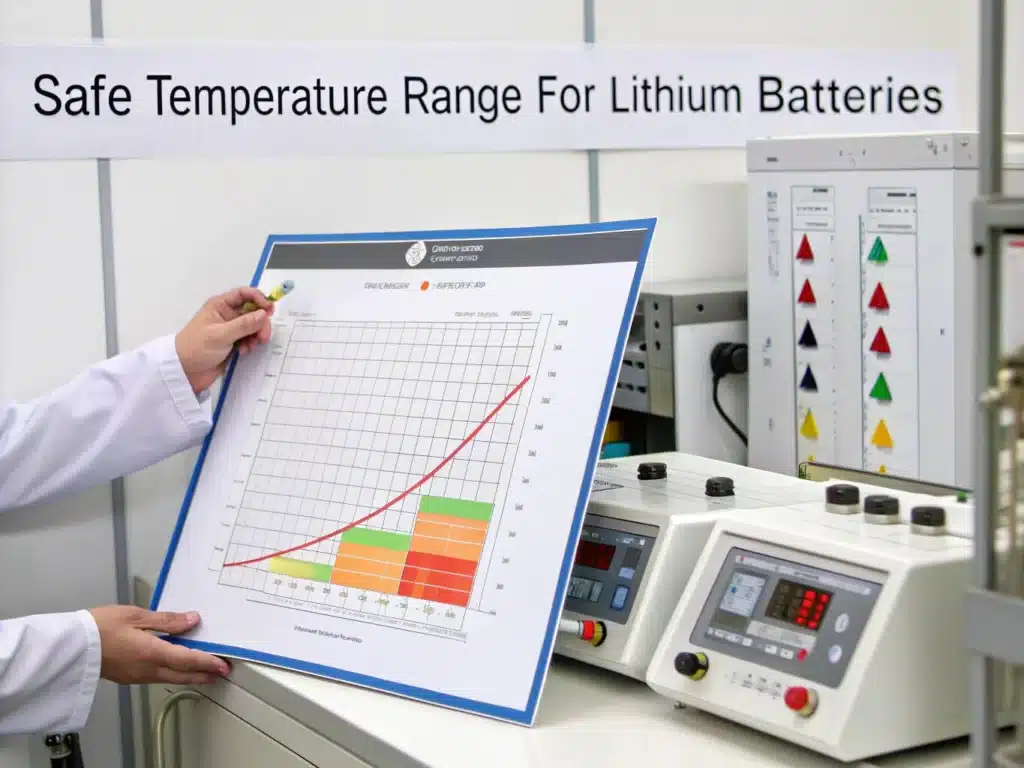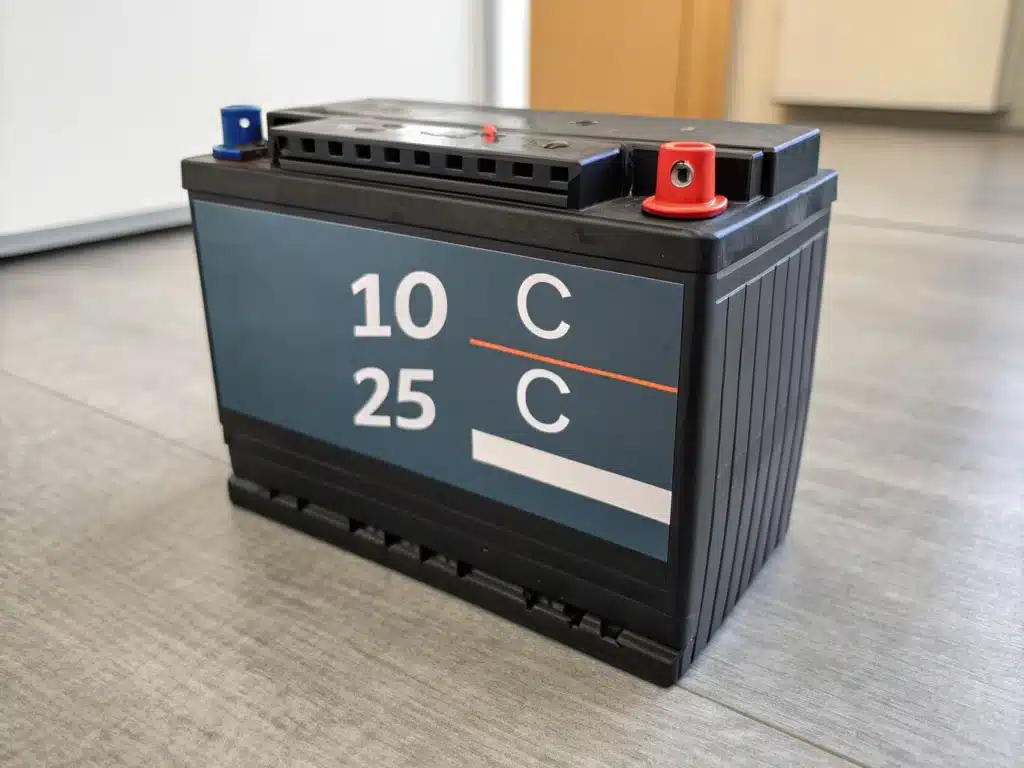Many of the devices we use every day are powered by lithium-ion batteries. But have you ever noticed that your phone loses power faster in the winter, or worried about leaving your electronics in a hot car? These phenomena are not accidental, they all point to a key factor: temperature is critical to the safety and life of lithium-ion batteries. Understanding and managing battery temperature can avoid potential dangers and significantly extend the life of the battery. This guide will explain to you why temperature is so important and clearly point out the key temperature range for safely charging, using and storing lithium batteries.
Table of Contents
ToggleWhy temperature is critical to lithium-ion batteries

Many people may have experienced that batteries are not durable, lose power quickly in winter, or heard news about batteries swelling or even catching fire. These indicate that improper temperature is one of the culprits.
The temperature requirements for charging, using, and storing lithium batteries are very different. You may think that the battery can be charged as long as it can be used, but in fact the safe temperature range is completely different. For example, the temperature window for charging is actually quite narrow. Never charge below freezing temperature (0°C). Low-temperature charging will cause permanent and irreversible damage to the battery, greatly increasing the risk of short circuit and fire in the later stage. Similarly, high temperature is a life killer and safety hazard for lithium batteries. High temperature will sharply accelerate battery aging and capacity decay, and is also the main cause of battery bulging and even fire.
Temperature sensitivity of lithium-ion batteries
The energy storage and release of lithium batteries rely on chemical reactions at the positive and negative electrodes. Temperature directly affects the rate and efficiency of these reactions.
Excessive temperature: It will accelerate battery aging (capacity decay), produce side reactions, generate gas, bulges and other adverse phenomena, and even cause the risk of thermal runaway.
Too low temperature: It will reduce the activity of the battery and make its discharge performance poor. When charging, low temperature will cause lithium metal to precipitate on the surface of the negative electrode, causing permanent damage and serious safety hazards.
The battery has completely different temperature tolerance and safety requirements when in the three states of charging, discharging (working) and storage.
What is the safe temperature range of lithium batteries
There may be differences between different types, brands, and models of lithium batteries. Please always check and follow the official instructions or specifications provided by your battery or device manufacturere.

Charging temperature for lithium ion battery
Ideal range: 10°C to 45°C (50°F to 113°F). Charging within this range provides the best efficiency and safety for the battery with minimal impact on life.
Acceptable range: 0°C to 45°C (32°F to 113°F). Below 10°C, the charging rate may be limited. It is recommended to charge the battery at 0~10°C and 0.2C rate. Above 45°C, there is a risk of battery charging.
Do not charge at or below freezing (below 0°C / 32°F). When charging at low temperatures, lithium ions cannot be smoothly embedded in the negative electrode material, and needle-shaped metal lithium crystals will form on the surface of the negative electrode, which is called “lithium precipitation”. This is irreversible and permanent damage. Read more.
Lithium ion battery operating temperature
Typical operating range: -20°C to 60°C (-4°F to 140°F). This range is much wider than charging.
Below 0°C: The battery’s discharge capacity will be temporarily weakened and the actual output power will drop significantly (the battery will feel weak and not durable), but this is usually recoverable and performance will improve after the temperature rises.
Max 60°C: Continuous high temperature use will accelerate battery aging and capacity decay. If the temperature exceeds 70°C, the risk of thermal runaway will increase dramatically.
Storage temperature for lithium ion batteries
Ideal long-term storage: A cool, dry, stable environment around 15°C (59°F) is recommended.
Avoid long-term exposure to extreme high temperatures (such as in a car on a summer day) or storage in environments below freezing.
For long-term storage (more than one month), it is recommended to keep the battery charge at around 40% – 60% and avoid storing it with a full charge or a completely depleted battery.
Regular inspection: For batteries stored for a long time, it is recommended to check the battery level every 3 months and recharge the battery to the recommended storage voltage range if necessary.
What happens if the temperature limit is exceeded
You already know the recommended temperature range, but what exactly happens if you exceed those limits?
Dangerous consequences of high temperatures

The most direct impact is the accelerated irreversible aging of the battery. You will find that the battery capacity drops rapidly, becomes less durable, and the internal resistance increases, which is manifested in a decrease in output power and an increase in heat.
High temperatures will cause the electrolyte to decompose and produce gas, causing the gas pressure inside the battery to rise and cause the battery to bulge. This not only damages the assembly, but also signals internal abnormalities.
The internal materials of the battery may degrade or deform at high temperatures, increasing the contact between the positive and negative electrodes and causing the chance of internal short circuit.
Under extremely high temperatures, combined with battery overcharging, internal defects, and physical damage, thermal runaway may be triggered. This is a chain exothermic reaction that may cause the battery to smoke violently, fire, or even explode.
Dangerous consequences of cold temperatures
Charging below freezing point causes lithium precipitation, which is the most dangerous signal. As mentioned above, this will lead to permanent loss of battery capacity and a sharp reduction in lifespan, and the precipitated lithium dendrites will bury a huge safety hazard of positive and negative short circuits, which may damage the equipment at any time and even threaten personal safety.
If you use the battery at temperatures below -10°C or -20°C, you will notice a sharp drop in voltage and a sharp reduction in available power. If you force a large current to work at this time, especially when cold starting the device, it may damage the internal structure of the battery.
Although not as fatal as low-temperature charging, long-term exposure of batteries to extreme low temperatures for storage may also have an adverse effect on the long-term performance and stability of the electrolyte.
How to manage battery temperature in daily life
You may know the importance of temperature, but how can we manage battery temperature in our daily life? Here are some simple and practical tips:
Best practices when charging

Try to charge the battery at room temperature (close to the ideal range of 10°C – 25°C / 50°F – 77°F).
If the battery feels hot to the touch after just operating at high power, please leave it to cool for a while and then charge it after the surface temperature returns to normal.
If you bring a battery back from a cold outdoor environment (especially below 0°C), be sure to wait until the temperature returns to room temperature before charging it. Remember not to charge a cold battery directly.
Best practices when using
During the high temperatures in summer, be sure to avoid leaving mobile phones, power banks, drone batteries and other devices in cars, windowsills or other enclosed high-temperature environments under direct sunlight for long periods of time.
When using electronic devices outdoors in low-temperature environments in winter, it is best to keep them warm in your pockets first.
When performing high-power output (such as playing large games, fast charging, and drone flying), ensure that the device is well cooled and do not block the heat dissipation holes to avoid heat accumulation.
Best practices when storing
Choose a cool, dry place with a relatively stable temperature to store batteries or devices containing batteries. Avoid storing batteries in places with large temperature fluctuations for a long time.
For batteries with high energy density and relatively high risks (such as model aircraft and drone batteries), it is recommended to use lithium battery safety bags or explosion-proof boxes for storage to add an extra layer of safety.
Daily precautions
Check the battery visually regularly. If you find any abnormal signs such as bulging, damage, leakage, odor, etc., stop using it immediately and dispose of or recycle it properly in accordance with local regulations.
Always use original or reliable chargers and charging cables that match specifications. Poor quality charging equipment is one of the common causes of battery accidents.
Always check manufacturer specifications
Throughout this article, general guidelines are provided based on common industry understanding.
Different brands, models, and even different batches of batteries may have significant differences in their internal chemical systems (lithium iron phosphate and ternary lithium NMC/NCA, etc.), battery management system (BMS) design and safety thresholds. We recommend that you read the official instructions for the batteries and devices you use, and use the specific temperature limits (charging, discharging, storage) provided by the manufacturer as a reference standard.
What to do if the battery is exposed to extreme temperatures
Despite our best efforts, the battery may be accidentally exposed to temperatures that are too high or too low to be safe. If this happens, please remain calm and take the following steps immediately:
In a safe, well-ventilated area, carefully inspect the appearance and performance of the battery.
If you have any doubts about the condition of a battery, stop using it immediately.
Batteries that are confirmed or highly suspected to be damaged should be treated as hazardous waste and recycled.
Conclusion
You may know the temperature preferences of lithium batteries during charging, use and storage. There are two main risks you need to be aware of: never charge at low temperatures (especially below 0°C) and avoid exposing the battery to extreme high temperatures for a long time. Develop and practice good battery temperature management habits to keep your battery performing at its best safely.
FAQs
Slight heating is normal: Under high load (such as playing games or video calls), the phone may feel slightly warm.
Excessive heating is not normal: If your phone becomes extremely hot, this may be a sign of a battery problem and you should stop using it immediately.
Impact of low temperature: Low temperature will reduce the available capacity and power output of the battery, resulting in a decrease in the range of electric vehicles.
Swelling, decreased performance, failure to charge: these are all signs that your battery may be damaged by overheating.
